Camelford - North Cornwall - Bodmin Moor - - Holidays in Camelford Tourism Guide

Padstow | Wadebridge
| The Camel Estuary | Rock
| Polzeath | Port
Isaac | Trebarwith Strand
|Tintagel | Bossiney
Cove | Rocky Valley
| Boscastle | Crackington
Haven | Bude | Clovelly
| Launceston | Camelford
| Altarnum | Bodmin
 |
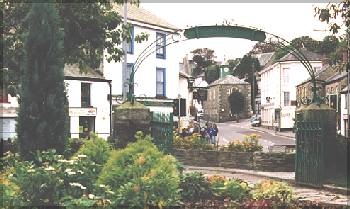 |
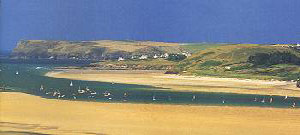 |
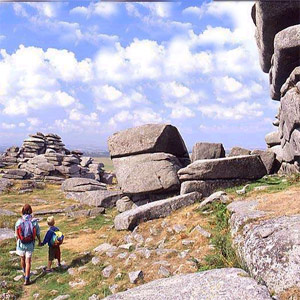 |
CAMELFORD
The gateway to Camelot Country
Access to this part of Cornwall has been made somewhat easier since the dualling of the A30 trunk road from the end of the M5 and, once passed Exeter, you are only one hour from your destination. Skirting north of Dartmoor, with the promise of Bodmin Moor ahead, you turn off towards Camelford in the direction of the North Cornwall coast - a quieter part of this holiday county with plenty of "off-the-beaten-track" places where you can choose to hide from summer crowds.
Camelford is an attractive and ancient town which straddles the A39, the Atlantic Highway trunk road, between Bude and Wadebridge and which is situated on the River Camel. It has some 2000 inhabitants and lies on the edge of Bodmin Moor. It is about six miles inland from the spectacular North Cornwall coastline, with the delightful villages of Boscastle and Tintagel, and the beautiful beaches of Bossiney and Trebarwith Strand.
 |
|
Port Isaac |
A little further afield we find the quaint fishing village of Port Isaac, to the north the coastal resort town of Bude and, to the east, historic Launceston.
To the south-east lies Bodmin, formerly the county town, to the south, Wadebridge, which like Camelford, is on the River Camel, now nearing its beautiful estuary. The scenic expanse of Bodmin Moor spreads away to the east and north of the town. On the Moor fascinating villages such as St Breward and Blisland beckon the traveller.
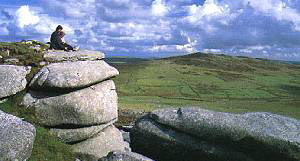
Roughtor - Bodmin Moor
In short, Camelford is at the heart of a marvellous area for touring, walking, fishing, swimming and surfing. It is steeped in history and legend. The town itself, and its immediate area, offer excellent shopping facilities and sporting facilities for golf, swimming and other activities.
Camelford - a centre for touring
Gardens to visit - visit the Tourist Information Centre
for an up to date list
Excellent beaches with lifeguards - at Trebarwith Strand, Polzeath
and Bude
Steam Railways - at Bodmin and Launceston
Boscastle and Port Isaac - visit the picturesque and working harbours,
buy locally caught fish
Scenic drives - along the coast and across the moors
Local Heritage Sites to visit at
- Roughtor - the 2nd highest hill in Cornwall and site of bronze age hut circles
- Delabole Slate Quarry - the largest man-made hole in the western hemisphere
- Tintagel Castle - with its myths and legends linking it to King Arthur
- The Old Post Office - a 14th Century former manor house at Tintagel
- Pencarrow House and Gardens - home of the Molesworth St Aubyn family
- Lanhydrock House and Gardens - 17th Century National Trust property
- Jamaica Inn at Bolventor - the inspiration for Daphne du Maurier's famous novel
- Daymer Bay and St Enodoc Church - the home and burial place of poet laureate John Betjeman
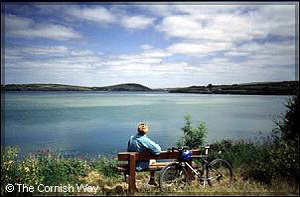 Camelford
- a centre for many sporting activities
Camelford
- a centre for many sporting activities
The Sports Centre, with a sports hall, tennis courts and
indoor heated swimming pool
3 Golf Courses within the immediate vicinity,
including "pay and play"
Riding Stables Walking - coastal footpaths and moor land trails
Cycling - along the Camel Trail and the South-west Cycle Way
Camelford - Heritage
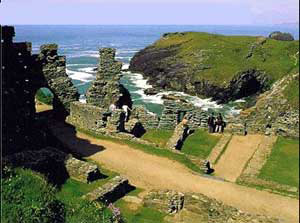 Some
believe that King Arthur and his Knights form
part of the North Cornwall history, and that Camelford was once the famed
'Camelot'. The truth is lost in the mists of
time, as is the name of the real warrior king who died in a bloody battle
just outside Camelford at Slaughters Bridge. Was it Arthur?
Some
believe that King Arthur and his Knights form
part of the North Cornwall history, and that Camelford was once the famed
'Camelot'. The truth is lost in the mists of
time, as is the name of the real warrior king who died in a bloody battle
just outside Camelford at Slaughters Bridge. Was it Arthur?
More reliable information tells us that the ancient town of Camelford was situated on an old medieval trading route and became an important centre of commerce when a royal charter was granted in 1259 by Richard, Earl of Cornwall, which created the present Borough. In 1552 Edward VI gave Camelford the right to send two members to Parliament, a right which continued until 1832, when the Reform Bill abolished the two "rotten boroughs", including Camelford. As a result if its favoured position, the town's inns and businesses thrived and the patronage of its MPs brought a lot of money into the town, which is reflected in some handsome buildings.
The symbol of the camel, as used on the Town Hall weather vane, is often used in connection with the town of Camelford, but actually the name has nothing to do with camels. The word Camelford is thought to derive from cam = crooked, alan = beautiful and ford. Thus Camalanford, contracted in the course of time to Camelford. The river Cam (which in Celtic means crooked stream) was easily forded by early travellers. Records show that there has been a bridge here since 1521.
Camelford - Historic Town Trail
From Churchfield Car Park:
(1) St Thomas Church, adjoining the car park, is a modem building (1938). The parish church is at Lanteglos, about 1.5 miles from the town, originally Norman. In 1311 the Camelford burgesses (leading citizens) built their own chapel near the river crossing in the town and dedicated it to St Thomas of Canterbury. However, this was despoiled at the Reformation, fell into disrepair and was eventually demolished. The name alone remains to connect the old with the new.
Because Bodmin Moor presented such difficult terrain for travellers (John Wesley got lost there in 1743), the old roads skirted round to north and south, and Camelford was an important staging post on the northern route. In the mid- 18th century there was a great move to improve the main through roads and Turnpike Trusts were formed. Money for the work was raised by tolls; there were three toll-gates (turnpikes) on the roads into Camelford. The Reverend William Phillips, vicar of Lanteglos at the time, was an ardent supporter of the cause and made himself responsible for many of the granite milestones along the turnpike roads, some of which are still in place. The mail coaches, which also carried passengers, travelled regularly along this road.
(2) The Town Jail: Crossing the road from the car park you come to a long building (now an agricultural suppliers) which was once the town jail, where during the Napoleonic wars it is said that many French prisoners of war were locked up. During the First World War it became a cheese factory and, later, it was used as an army barracks and nursing home.
Turn towards the bridge and you will cross the entrance to College Road, so called because Sir James Smith's Grammar School was there (about 100 yards up the road) from 1894 until the new comprehensive school was built in 1962 at the top of the town.
The original foundation was endowed in 1679 by Sir James Smith, MP for the town, but because of "misappropriation of the funds" the school did not function until the 19th century. The present school, at the top of the town, was opened in 1962 and dedicated to Sir James Smith as the first man to support education in the town. It was the first comprehensive school in Cornwall and was the brainchild of the then headmaster, Kenneth Sprayson, who was awarded the MBE for his contribution to education in Cornwall. The former Grammar School buildings are the offices of North Cornwall District Council. Close to the offices stands Highermead, the former residence of the Headmaster.
(3) The handsome Bridge House, on the left, shows that by the mid-17th century, Camelford was a sufficiently prosperous place to be deemed suitable for a substantial "gentleman's residence". Looking back at the gable-end of the house from the bridge you can see how the roof was raised (probably in the late-18th century) to accommodate a third story, making the house even more imposing. The name of the town tells us the earliest crossing of the River Camel at this point was a ford, but certainly there has been a bridge here since 1521, when there are records of it being repaired. Probably the earliest one was of timber, to be superseded later by stone.
As carts and carriages got bigger and heavier, the bridge would have been strengthened and widened. Most recently, the river bed underneath has been deepened, to accommodate the floodwater after heavy rain, which used to flood the lower part of the town.
(4) The Mason's Arms: Shortly after crossing the bridge, you will come to the Mason's Arms on the left, obviously a coaching inn with its two big archways. The earliest part of the building (c1600) is that on the right and it was progressively extended down the street in the next 200 years. Behind the pub, in what was once the stable yard, are three tall posts, all that remains of the stables where jingles, or small carts, were kept. In 1755 the inn was described as "that ancient commodious and well-accustomed inn .... situate in the great post road from London to Falmouth".
(5) Next door but one is the "Free Methodist Chapel". This was built in 1837 by a group of Wesleyans who had rebelled against the "despotic and tyrannical" organisation of the Central Methodist Conference and had been banned from the original chapel in Back Street. At the time of its opening, the chapel was described in the "West Briton" as "a neat building and an ornament to the town".
(6) Just up the road, where Chapel Street forks off to the right, stands the Town Hall, topped with a weather-vane in the shape of a golden camel. It was built in 1806 by the Duke of Bedford. Originally the ground floor was a market house, with the main entrance in the centre, facing the road. The upper chamber is reached from Chapel Street by a double flight of granite steps and in 1906, was still the meeting place for the Petty Sessions, County Court and the Education Committee. The building is now the town library. By the entrance can be seen an old bell, presented to the town by the Mayor, W Prideaux, in 1699. It used to hang in the cupola (the small dome over the clock tower) and served to warn townspeople of fire or any other calamity. The stained glass "Venetian" window above this entrance carries the old borough's arms and was a gift to the town from T E Wakefield in 1933.
(7) and (8) Going up Fore Street you will notice, on both sides, alleyways or "opes" between the houses, which gave the householders and shopkeepers access to their rear premises and provide short cuts between Fore Street and Chapel Street, or Front and Back Streets, as they were once known.
(10) Turning right, up Clease Road, the old elementary school, built in 1843 for 300 children, is on the left. On the right is the North Cornwall Museum and Gallery, originally a coach and wagon building business. Below this is the old cattle market.
(11) Turning right past the museum, you come into Chapel Street, which has cobbled gullies running down each side, with a little slate bridge to each house.
(12) Part way down the hill on the right is the Old Slaughter House. The chapel, after which the street is named, is about halfway down the hill on the left. The date, 1810, is over the door, but this building replaced an earlier one, built in 1785, during John Wesley's lifetime. Wesley was a regular preacher in Camelford from 1747 onwards. At his first visit he was stoned and hounded out of the town, but he later built up a strong following. Facing the Methodist Chapel is the old Sunday School. The imposing building to the right of the gateway was once the Manse or minister's house.
(13) Further down on the left is Warmington House, home to Sir James Smith MP in the 17th century. It was bought by George Warmington in 1704 for £90. In 1722 he sold the house to Lord Falmouth. A hundred years later it was bought by the Earl of Darlington, one of the great patrons of the town.
The next turning on the left is Mill Lane. The old mill house is on the right-hand side of the lane, behind the shop on the corner. A leat from the River Camel turned the water-wheel and was then channelled under the road and so back to the river. The next door building was the grain store for the mill. Some years ago, workmen found that the spaces between the first-floor joists were choked with chaff, which had to be carted away by the sack full. Looking across the street, on the gable end of the building below the Mason's Arms, can be seen a tiny chink in the wall, through which the residents could read the time on the Town Hall clock.
Immediately before the bridge is the entrance to Enfield Park, which was presented to the town in 1922 by Albert Tingcombe, a Camelford tailor, who lived in Enfield for most of his working life and then returned to his birthplace. Previously on this site was the Acetylene Gas Company, which produced gas lighting in the town. The process involved adding water to calcium carbide, the resultant gas being piped into large storage containers. The old mill leat can still be traced along the upper edge of the park.
(14) The large white house on the other side of the bridge is known as the Manor House or simply Camelford House. Its most famous owner was Thomas Pitt 2nd and last Baron of Camelford, cousin of William Pitt, the Prime Minister. During a short but adventurous life, Lord Camelford ran away from school to join the Navy at the age of 14, was shipwrecked, flogged and court-martialled; he travelled secretly to France planning to assassinate Napoleon and was finally killed in a duel at the age of 29.

|
Where to Stay Locally |
 |
|
|
Late Vacancies & Special Offers |
 |
|
Promoting
your business on Cornwall Online |
|
Cornwall
Online is a trading name of ITS WEB DESIGN - COL DIRECT
Cornwall Online Website by ITS WEB DESIGN - COL DIRECT. Tel 01579 557343 Please ensure that you confirm all details with the Advertiser before Booking We recommend that you take out Holiday Insurance on ALL Bookings |
